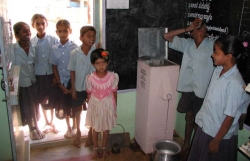1. Bio-Sand Filters Work Simply
No chemicals, moving parts, exterior pipes or electrical apparatus are used. There is virtually no maintenance or operating costs. Under the lid there are simply five layers inside an installed filter’s concrete container:
- Diffuser splash plate
- Bio-layer colony
- Fine sand layer
- Course sand layer
- Gravel layer
Copper pipe encased in filter wall runs from gravel layer to spout.
2. Bio-Sand Filters Are A New Innovation Of An Old Design
Bio-Sand Filters are classed as a “slow sand filter” that removes pathogens with biological and mechanical actions. When dirty water is poured into the filter, the organic material it carries is trapped on the surface of the fine sand. Within one to three weeks a colony of microorganisms forms a bio-layer or “schmutzdecke” (literally “dirt blanket” in German) that feed off the bacteria, organic food and oxygen found in the dirty water. Experts call this process “predation.” Pathogens also die from lack of food and less than optimal temperatures inside the filter (“natural death”). In addition, viruses stick to the sand grains (“absorption”) where their own cells eat them or the viruses become inactivated by antiviral chemicals produced by the microorganisms in the filter. The sand also absorbs certain organic compounds. Other cysts, worms, metals and sediments are caught in spaces between the sand grains (“mechanical trapping”). The pathogens captured by the filter die from lack of nourishment or are consumed by the microorganisms, keeping the filter from becoming a breeding ground for bacteria.
3. Bio-Sand Filters Are Very Effective Water Cleaners
Tests done by numerous health and water sanitation studies collected by the Centre for Affordable Water Sanitation Technology (CAWST.org) report that: “The filter has been tested by various government, research, and health institutions, as well as by non-governmental agencies."
Overall, these studies have shown that the Bio-Sand Filter removes:
- All suspended sediments
- 100% of protozoa and helminthes
- More than 90% of fecal coliform
- 50-90% of organic and inorganic toxicants
- 95-99% of zinc, copper, cadmium and lead
- < 67% of iron and manganese
- < 47% of arsenic
4. Filtered Water Can Require Additional Purification
Although the Bio-Sand Filter does remove more than 90+% of bacteria, which is often below infectious levels, filters do not always remove 100% of fecal coliform, the ideal standard for clean water from the World Health Organization. For households with infants and elderly people, it is recommended that filtered water also be disinfected by boiling or adding disinfectant for maximum purification.
5. Clean Water Is Produced Immediately
Dirty water poured into the filter comes out immediately at the rate of about 1 liter a minute or 60 liters per hour (about 15 gallons). Water goes through the filter so fast a receptacle must be in place before water is poured in the top. A filter can be used on an “as needed” basis as often as the household needs clean water.
6. Bio-Sand Filters Require Minimal Maintenance
Most biological pathogens, including e. Coli, coliform bacteria, viruses, etc. are consumed by the bio-layer organisms. As for sediment, continued use of very turbid water can plug the find sand grains at the top of filter. The sand and water layer can be stirred and the sediment-filled water removed to restore flow rates.
7. Bio-Sand Filters Are Low-Cost By Design
Bio-Sand Filters are manufactured in the Kolar Workshop very efficiently and economically. Filters are sold at a subsidized price of about half the direct cost of manufacturing to allow the widest acceptance of filters by the poorest village households.



